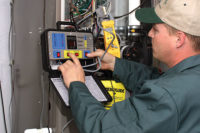
The economy has spoken, and business will be different from here on out. Having reshaped the marketplace, it appears the financial fallout could be at an end. HVACR contractors are beginning to move beyond a 2009 survival stance and posture themselves for the predicted recovery in 2010.
Despite the hopeful outlook, business as usual no longer exists and contractors from across the nation are taking new approaches to the HVACR industry.
CASH FLOW OBSTACLES
One of the biggest changes to the national market- place is the lack of cash flow, both on the commercial and the residential side of the industry. The commercial market was hit particularly hard last year. According to Paul Stalknecht, president and CEO of Air Conditioning Contractors of America (ACCA), the sector was hit a little later than the residential market and is experiencing a deeper, longer downturn.“Many commercial contractors rely so predominantly, if not entirely, on construction activity that their decline was to be expected in the current economic environment, and they are now having to change their operations and focus, expanding into service sectors that provide revenue when construction is not there,” he explained. “As one large commercial contractor said to me, ‘We always had a proposal and bid mentality, now we have to discover a marketing mentality.’ ”
Traditionally offset by credit, limited cash flow is also creating a problem for residential contractors as well, especially on the consumer side.
In a survey conducted of ACCA members, it was reported that 29 percent had seen a small increase in the number of customers being turned down for financing and 45 percent had seen a significant increase in turndowns.
“The number of independent financing companies serving the HVACR industry has dwindled considerably,” said Stalknecht. “Contractors must get creative to find ways to help their customers locate financing when they need it, including such options as credit unions, regional banks, etc.”
Ken Bodwell, operations manager, Innovative Service Solutions, Orlando, Fla., pointed out the problem is not necessarily cash availability.
“Banks have a lot of cash available, but because of threatened penalties and uncertain tax liabilities, they are not loaning money,” he explained. “We are seeing some of our smaller manufacturing clients struggling to stay afloat and not repair or replace their bad equipment. The effect on us will eventually be slower paying of our vendors and an inability to take advantage of opportunities because of cash flow.”
Another reason credit approvals are dropping is that the number of independent financing companies serving the HVACR industry has dwindled considerably, according to ACCA.
Gastonia Sheet Metal Heating & Air in Gastonia, N.C., has experienced a significant drop in credit approvals. The company has gone from 60-70 percent qualifying for financing to 30 percent in the last 12-18 months.
“This is directly causing a loss of volume that we would have otherwise had,” said Steven Long, president, service and residential divisions, Gastonia Sheet Metal Heating & Air. “I believe the buying habits of many consumers have changed permanently due to the economic conditions of the past 18-24 months.”
“This is a tough market for everybody. Some commercial markets did hold up better in 2009, but most of us are working through our backlog,” said Robert Armistead, PE, president, Armistead Mechanical Inc., president elect Mechanical Contractors Association of America (MCAA). “A few of the brighter spots are sustainable construction and federal projects. But our situation won’t really turn around until the Main Street economy starts growing again, and that won’t happen until credit starts to flow.”
BIDDING BATTLES
Not only is the economy affecting contractor and consumer cash flow, but it is also driving equipment and maintenance prices lower than normal. According to John Lindemulder Sr., president, Sheet Metal and Air Conditioning Contractors’ National Association (SMACNA), bidding wars are more fierce as the fight to gain contracts intensifies.“Before the economic downturn, there might have been five or six contractors on the bid list. Now, often there are 25 or more,” explained Lindemulder. “Bidding has been tight and close as margins disappear, members are increasingly wrestling with overhead and productivity issues. Contractors must focus on bidding jobs that include a profit.”
Further changing the behavior of some contractors, the economy has made many of them, including Karl Roth Jr., CEO, AN Roth Co. LLC, Louisville, Ky., more concerned about getting paid for jobs.
“It is very difficult to make sure that a customer has the ability to pay,” he said. “We have, in the past six months, walked away from projects after fighting to win them. We want to know where the money is before we start.”
Paul Sammataro, president, Samm’s Heating and Air Conditioning, Plano, Texas, is concerned that price-cutting practices will permanently change the HVACR market. “We have noticed customers looking for the lowest price more than ever. Also, we have seen struggling companies slash their pricing,” he said. “The more contractors that do this and the longer that practice lasts I feel will eventually change the market.”
To combat this new trend, Sammataro’s company has kept pricing at 2009 levels for 2010 and has added a second brand to offer a more economical solution for those needing one.
INSURANCE WOES & ARRA
Another financial hot topic in the HVACR industry is insurance. Health insurance especially continues to threaten contractor livelihood as premiums increase at a steep and steady rate.David Hutchins, owner and president, Bay Area A/C, Crystal River and New Port Richey, Fla., said that insurance costs are getting close to prohibitive. To help control the increase, he shops around for the best insurance rates more than he ever has in the past.
John McCarthy Sr., president, McCarthy’s One Hour Heating & Air Conditioning, Omaha, Neb., agrees that insurance prices are becoming prohibitively expensive. “The biggest problem is that insurance does not have a top,” he said. “Whatever we do, they keep raising the cost.”
The health care issues remain a high priority topic for the legislators on Capitol Hill. Heated debates have continued for months, but one thing both sides of the aisle agree upon is the need for reform, especially if small businesses are to survive.
A second piece of legislation affecting HVACR contractors greatly this past year was the American Recovery and Reinvestment Act of 2009 (ARRA). According to several commercial and residential contractors, ARRA did not provide much relief in creating jobs for the HVACR industry; however, the geothermal tax credits made available, along with the weatherization provisions, gave some industry members’ businesses a shot in the arm.
“Tax credits for air source and geothermal have been a big help in selling higher efficiency systems,” said Brian McDonald, owner/general manager, Outer Banks Heating & Cooling, Kill Devil Hills, N.C.
Roth experienced much the same results in his firm. “We are selling a lot of geothermal systems now, residential as well as commercial,” he said. “The ARRA geothermal tax credit is helping drive a lot of business.”
BUSINESS SOLUTIONS
Providing new ways of dealing with the different economic landscape, future trends are promising an influx of business and renewed profitability. Building information modeling (BIM) is one such trend that is quickly gaining ground. With an emphasis on efficiency and sustainability, some of the contractor benefits of BIM are “getting them involved in the planning stages of the project and staying in the game longer,” said Lindemulder. “We see building information modeling as one way to get our members ahead.”Another influx of revenue is coming from business add-ons. Contractors are increasingly providing more services to consumers in an effort to mitigate the decline in new installation sales. Some examples include: weatherization, back-flow certification testing, ductwork cleaning and sealing, stand-by generator installation, insulation installation, building envelope improvement, etc.
“We are more diversified than ever to combat the flat economy and overhead costs,” said Hank Bloom, president, ECS, Mentor, Ohio. “Building our service group and controls company will help. So far, service has not been affected.”
2010 PENCIL SHARPENING
Continuing to keep an eye on technician shortages, insurance rates, education, fuel prices, and the overall economy, HVACR industry contractors are improving their outlook and sharpening their pencils in order to ensure success in 2010.“The work is there for the sharpest pencil in 2010 as it was in 2009,” said Ann Kahn, president, Kahn Mechanical Contractors, Dallas. “The trick is to be very careful with sharpening that pencil and to know when to back off and when to move on.”
Publication date:03/15/2010







